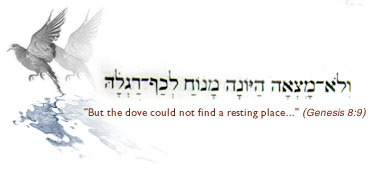

"At the
end of forty days" of deluge, Noah begins to send out birds "to see if the waters
were abated from the face of the ground." He sends out a raven several times,
then a dove at seven-day intervals. The dove returns the first time "empty-billed,"
the second with an olive leaf; when she fails to return the third time, Noah
understands that she had found a resting place on dry land.
Flood stories
were quite popular and widely distributed among the various peoples of the ancient
world; many of the details described in the Genesis flood story are echoed in
other ancient myths. The bird-dispatching episode, which makes its appearance
repeatedly in numerous ancient flood myths, derives from the practice of mariners
in ancient times to take shore-sighting birds aboard and to release them in
order to determine their proximity to land
In a remarkable
study entitled "The Role of Birds in Early Navigation,"[1]
James Hornell shows that several ancient cultures across the globe used birds
for the purpose of finding out whether there was land within a navigable distance,
and in what direction. He notes references in the Hindu Sutta Pitaka
(fifth century BCE) in which the ancient Hindu merchants carry aboard several
"shore-sighting birds" when sailing on overseas voyages; these birds were "used
to locate the nearest land when the ship's position became doubtful."
This practice
is mentioned also in the Buddhist Kevaddha Sutta of Digha, written about
the same period. Similarly, in the writings of Pliny of Imperial Rome five centuries
later, Pliny mentions this custom as practiced by the seamen of Ceylon when
making sea voyages, as they were unable to steer by the stars[2]
(a custom still practiced by Ceylonese seamen in the sixth century CE).
 Anthopologist
Raphael Patai notes that Hornell's study makes it likely that the traces
of some such practice were preserved in the ancient Akkadian and biblical
legends, in which birds are sent out by Xisuthros, Utnapishtim, Noah and
others to espy dry land. Anthopologist
Raphael Patai notes that Hornell's study makes it likely that the traces
of some such practice were preserved in the ancient Akkadian and biblical
legends, in which birds are sent out by Xisuthros, Utnapishtim, Noah and
others to espy dry land.
The first Mesopotamian flood
story known to the western world was that of Berossus, a 3rd-century
BCE priest of Marduk in Babylon, who wrote a 3-volume history of his country.[3]
Xisuthros, the hero of the flood story in Berossus's account,
sends out some birds from the vessel and they too return to him for after failing
to find food or resting place. He waits a few days, then sends them out again.
They return with their feet tinged with mud. The third time he sends them out
they do not return.
A similar sequence is related
in the most famous, detailed and complete of Mesopotamian flood stories — the
ancient Akkadian Gilgamesh Epic.[4]
Utnapishtim waits seven days after grounding before releasing a dove, then a
swallow, and then a raven to search for dry land. Utnapishtim relates:
When the seventh
day arrived,
I sent forth and set free a dove.
The dove went forth, but came back;
Since no resting place for it was visible, she turned round.
Then I sent forth and set free a swallow.
The swallow went forth but came back;
Since no resting place for it was visible, she turned round.
Then I sent forth and set free a raven.
The raven went forth, and seeing that the waters had diminished,
He eats, circles, caws, and turns not round
Then I let out (all) to the four winds,
And offered a sacrifice.[5]
|
[1]
James Hornell. "The
Role of Birds in early Navigation," Antiquity 20 (Sept. 1946),
pp. 142-49.[back]
[2] Pliny,
Historia Naturalis 6:22. [back]
[3] Berossus'
three-volume history of his country (275 BCE) covers the period from the
creation until conquest by Alexander. Although his original work has not
survived, we do have quotations that Greek historians included in their
works.
[back]
[4]
A copy of this epic, which takes us back as early as the third millenium
BCE, was found in Nineveh (the capital of the ancient Assyrian Empire
in the seventh century BCE), in the library of King Asshurbanipal.
[back]
[5]
In his article, "The
Biblical-Mesopotamiam Parallels," Nahum Sarna notes that just as "God
blessed Noah" after the flood (Genesis 9:1), so too does Enlil bless Utnapishtim.
[back]
|
|
 Raphael
Patai. The Children of Noah (Princeton: Princeton University
Press, 1998), pp. 10-11. Raphael
Patai. The Children of Noah (Princeton: Princeton University
Press, 1998), pp. 10-11.
 Nahum
M. Sarna. Understanding Genesis (NY: Schocken, 1972), pp.
40, 47. Nahum
M. Sarna. Understanding Genesis (NY: Schocken, 1972), pp.
40, 47.
Nahum
M. Sarna. The JPS Torah Commentary: Genesis (Philadelphia: The
Jewish Publication Society, 1989).
|
BIRDS
Table of Contents
|